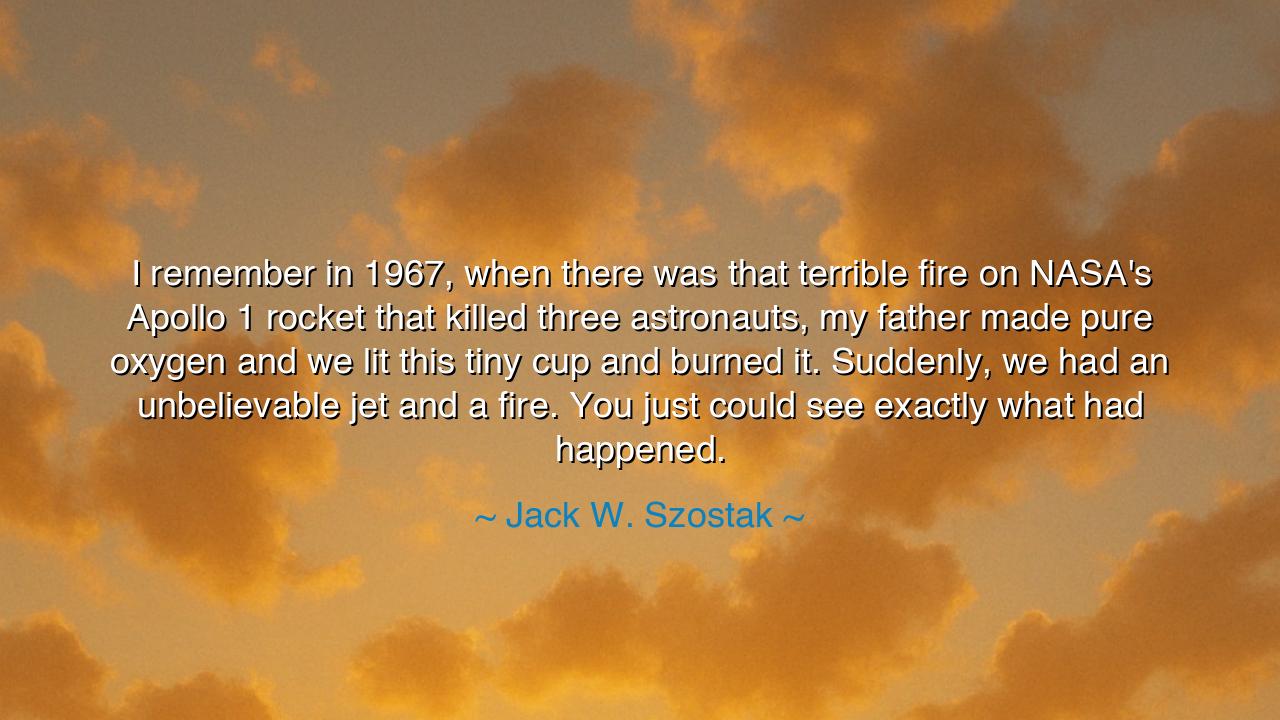
I remember in 1967, when there was that terrible fire on NASA's
I remember in 1967, when there was that terrible fire on NASA's Apollo 1 rocket that killed three astronauts, my father made pure oxygen and we lit this tiny cup and burned it. Suddenly, we had an unbelievable jet and a fire. You just could see exactly what had happened.






"I remember in 1967, when there was that terrible fire on NASA's Apollo 1 rocket that killed three astronauts, my father made pure oxygen and we lit this tiny cup and burned it. Suddenly, we had an unbelievable jet and a fire. You just could see exactly what had happened." These poignant words from Jack W. Szostak draw us into a powerful moment of scientific discovery and personal reflection. The tragic Apollo 1 fire, which claimed the lives of three astronauts, was a devastating moment in the history of space exploration, revealing the grave dangers of the unanticipated consequences of scientific advancements. In Szostak’s recollection, the act of creating pure oxygen and observing the resulting jet and fire allowed him to understand, in an instant, the exact cause of the tragedy—a simple yet profound revelation that brought clarity to a moment of loss and sorrow.
In the ancient world, great thinkers like Archimedes and Galileo made their own breakthroughs through direct observation and experimentation. Archimedes, in particular, is remembered for his famous exclamation of "Eureka!", which came as a result of his own experiments with buoyancy. He had discovered a simple truth by observing how an object displaced water in the bath, a moment that would shape the future of mathematics and physics. Like Szostak’s moment of insight, these ancient figures were not simply gathering knowledge in the abstract but seeing and feeling the immediate consequences of their observations. Science, for them, was not an intellectual exercise alone; it was a deeply emotional, personal journey toward understanding the mysteries of the natural world.
The Apollo 1 disaster is a harrowing example of how scientific exploration and innovation can sometimes lead to tragic consequences. The fire on the Apollo spacecraft, caused by the presence of pure oxygen in the cabin during a test, was a result of unforeseen conditions and the incomplete understanding of the materials and environment required for space travel. This event was a wake-up call to the scientific community about the importance of safety, risk management, and the unintended consequences that arise from pushing the boundaries of human exploration. However, as Szostak’s story shows, understanding the root cause of the fire allowed for progress—not in repeating the same mistakes, but in learning from them. The fire that caused so much pain also lit the way for future innovations in space safety.
Szostak’s personal experiment with pure oxygen after the disaster is a reflection of the scientific method itself—observation, hypothesis, testing, and discovery. By recreating a similar environment in a controlled setting, Szostak could visualize exactly how the fire had occurred, connecting the dots between cause and effect. This experiment is a small, but profound, moment in the process of scientific discovery. It reflects the emotional impact that such losses have on those in the scientific community, but it also highlights the resilience of the human spirit to find understanding in the wake of tragedy. Just as Galileo used the telescope to see the moons of Jupiter and change our understanding of the universe, Szostak used his own small experiment to gain clarity on the dangers of space exploration.
The lesson embedded in Szostak’s reflection is one of resilience and learning through tragedy. In every field of inquiry—whether space exploration, medicine, or technology—failure and loss are inevitable parts of the journey. But it is how we respond to these challenges that ultimately defines our progress. The ability to take painful experiences, to observe them closely, and to derive lessons from them is what fuels advancement. Just as Einstein found beauty in the mystery of the universe and Darwin found the key to evolution in the smallest of creatures, Szostak found understanding in a small, controlled experiment that illuminated a larger truth. In every challenge, in every loss, there lies an opportunity for greater wisdom—if we have the courage to face it and the humility to learn from it.
Szostak’s reflection is also a reminder of the sacrifices made in the pursuit of knowledge. The astronauts who lost their lives on Apollo 1 paid the ultimate price for advancing the cause of space exploration. Their deaths were not in vain; they sparked a renewed focus on safety and innovation that would lead to the success of subsequent Apollo missions and the eventual landing on the moon. Similarly, in our own lives, the difficult lessons we learn through loss or failure can lead to a greater understanding of the world. It is through embracing the tragedy and pain of mistakes that we grow, evolve, and ultimately succeed.
The broader lesson that Szostak’s words impart is one of responsibility in the pursuit of discovery. With every new advancement, whether in science, technology, or any other field, there is an inherent risk—a risk that must be understood and mitigated. But just as important is the need to learn from failure, to use it as a stepping stone towards deeper knowledge. We must honor the sacrifices made along the way and recognize that progress is often born from pain. Like Szostak, we must be brave enough to experiment, observe, and accept the emotional impact of those failures, for in doing so, we find the clarity needed to move forward. Let us remember, as the ancients did, that true wisdom is not just about success, but about how we rise and learn from the trials we face.






AAdministratorAdministrator
Welcome, honored guests. Please leave a comment, we will respond soon